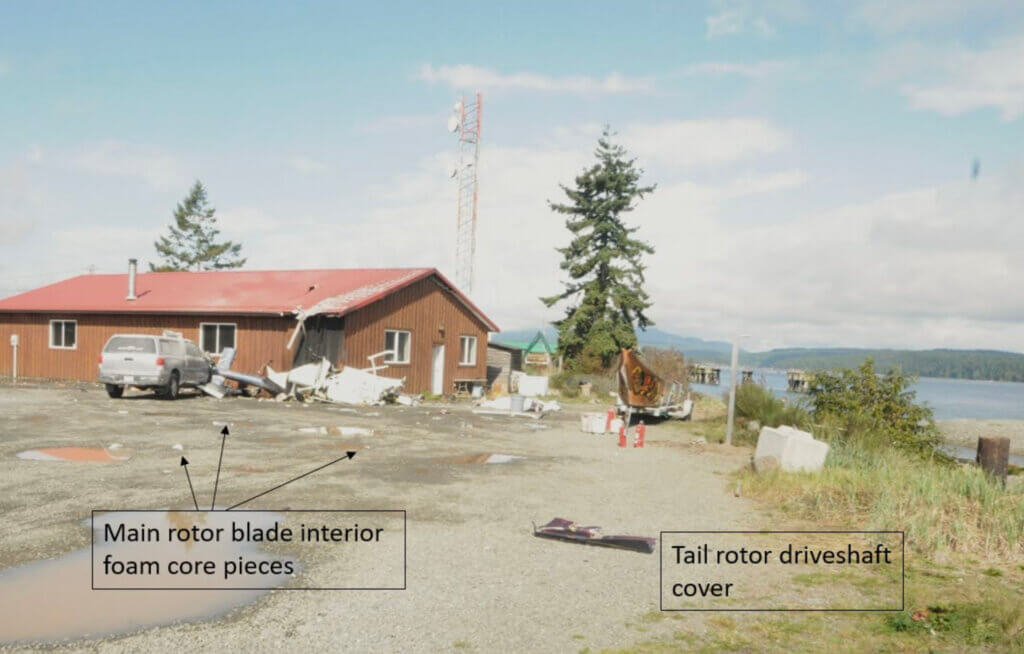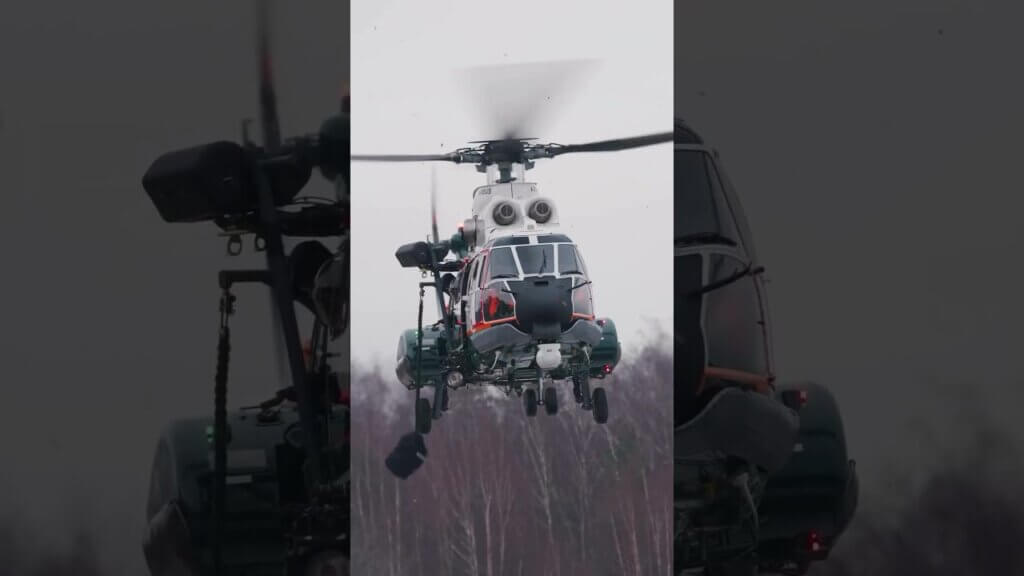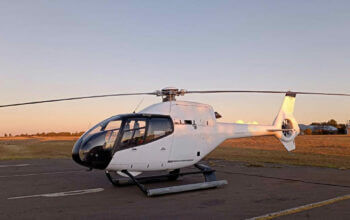
Two investigations of fatal helicopter accidents by the Transportation Safety Board of Canada (TSB) have been challenged by Robinson Helicopter Company and Van Horn Aviation, which contend that TSB investigators overlooked significant evidence and dismissed other, more likely scenarios in coming to their conclusions.
In both cases, the TSB determined that the crashes of the single-engine helicopters, a Robinson R44 and Bell 206B, were primarily due to main rotor blade failure, even though neither engine was producing power at the time of impact. In one of its accident reports, the TSB explicitly speculated that the pilot deliberately shut off fuel to the engine in response to main rotor vibrations, despite flying over heavily wooded terrain where a successful power-off landing would have been challenging.
In the other report, the TSB acknowledged that the helicopter was flying illegally with an improperly installed engine and had experienced a serious power anomaly just six days earlier, yet concluded that the cause of the crash was deformation of the main rotor blades in flight.
The TSB did not respond to specific questions regarding the accidents but emphasized that all of its investigations are undertaken by teams of transportation sector experts, and that its investigation reports follow a rigorous process and go through multiple layers of review. “All reports are also systematically reviewed and challenged by the independent members of the Board,” a TSB spokesperson said via email.
An overdue R44 in Quebec
One of the accidents was the crash of a privately owned Robinson R44 Raven I helicopter near Lac Valtrie, Quebec, on July 10, 2019. It killed both people on board, Quebec businessman Stéphane Roy and his 14-year-old son, who were missing for two weeks before the wreckage of the aircraft was discovered in dense forest.
The helicopter was found in an upright position on a rocky outcrop, closely surrounded by trees. Initial examination of the accident site, wreckage and main rotor blades indicated that the descent path was nearly vertical and the blades were rotating slowly when the aircraft fell through the trees.
The engine did not show signs that it was running at the time of impact, but there was no evidence of mechanical failure. One of the main rotor blades exhibited evidence of localized separation between the skin and the spar, and both blades had numerous deformations. The TSB decided based on its laboratory analysis that many of these deformations had occurred in flight.
Pointing to a documented history of debonding in that particular model of Robinson main rotor blades with stainless steel skins (C016-2), the TSB concluded that adhesive failures and a pre-existing manufacturing defect contributed to significantly reducing the stiffness of one of the blades. The agency speculated that this caused strong vibrations during the occurrence flight.
“A pilot faced with significant vibrations will tend to want to maneuver for a landing as quickly as possible,” the TSB wrote in its report. “Given that the examination of the engine did not show any mechanical defects or malfunctions, or typical signs that it was running at the time of impact, it is possible that the pilot cut the engine to try to reduce the intensity of the vibrations.
“At a certain point, the rotational speed of the main rotor fell too low, preventing the aircraft from remaining in flight. This was followed by a vertical drop and impact with the ground,” the TSB asserted.
However, Robinson, which formally objected to the TSB’s findings, pointed out that it would be unlikely for a pilot to respond to a severe vibration by cutting the engine. Doing so would immediately obligate the pilot to perform an autorotation and power-off landing — a tricky maneuver with little margin for error, especially in a heavily wooded area with relatively few clearings.
“Reducing power and descending to land would be a much more likely scenario, based on our piloting experience and training,” Robinson wrote in a submission to the TSB.
But the company also doesn’t believe that the pilot actually encountered any significant main rotor vibration in flight. The skin-to-spar separation the TSB discovered was inboard on the blade, not at the tip as in previous debonding incidents. While a blade delamination at the tip can progress rapidly as the skin peels up into the airflow, Robinson said, a “captive” separation inboard on the blade will not.
“The idea that this theoretical vibration would have progressed from undetectable, to so severe that the pilot had to ‘cut the engine’, in the timespan of a few minutes, or even hours, defies logic,” the company told Vertical, emphasizing that indications of adhesive failure and other deformations are often seen in accidents as a consequence of blade impacts and are unrelated to the cause of the accident. Robinson also noted that the observed condition of the rotor head and upright, generally intact condition of the fuselage are not compatible with the TSB’s hypothesized scenario of a rotor stall and extended free fall.
“The overall damage signatures in this accident are consistent with an aircraft that was in autorotation, the pilot possibly trying to reach a clearing but falling short or overshooting, followed by a flare and collective pull-up at the tops of the trees, and then falling through the trees to the ground,” Robinson said.
The company noted that although the weather at the time of the accident was clear, the relative humidity was conducive to carburetor icing, a condition in which ice builds up on the carburetor walls and throttle valve, restricting air flow to the engine.
The R44 Raven I has a carburetor heat assist system to reduce the likelihood of icing, but Robinson said the position of the carburetor heat control at the time of the accident could not be conclusively determined due to impact damage. Carburetor icing could cause a loss of engine power without leaving permanent evidence of the blockage.
Robinson told the TSB that carburetor ice was a significant possibility in the accident and should be recognized as such in the investigation report. However, the TSB’s final report does not mention the possibility of carburetor icing at all, and states: “There was no indication that weather was a factor in this occurrence.”
The TSB told Vertical it conducted a formal review of the investigation after the report’s publication “based on additional information provided by a designated reviewer. In this case, the Board called on an external body, the Australian Transport Safety Bureau, to review certain aspects of the investigation and final report. This resulted in some changes being made to the investigation report and a revised final version was issued in February 2022,” the TSB spokesperson said.
The revisions to the report were relatively minor, though, and did not significantly alter the agency’s conclusions. The ATSB published an acknowledgement of the review on its website but declined to comment further due to confidentiality reasons.

An unairworthy JetRanger in B.C.
The second accident was the crash of a Bell 206B operated by E&B Helicopters on Sept. 24, 2019. E&B owner and pilot Ed Wilcock, who was the only person on board, was killed in the crash, which occurred shortly after departure from the company’s heliport in Campbell River, British Columbia.
According to the TSB’s final report on the accident, the flight, which was for the purpose of resupplying a cabin about 25 miles to the south, was not in compliance with the Canadian Aviation Regulations (CARs) due to a known defect that rendered the helicopter unfit for flight. The week before, Wilcock had been flying the aircraft when it experienced a significant reduction in main rotor RPM of about 20 percent.
The incident and subsequent maintenance actions were not recorded in the aircraft’s journey log, contrary to the CARs. It was determined that the engine was not installed with the correct fuel accumulators and double check valve, which dampen fuel system instability due to vibrations inherent in the two-bladed rotor system of Bell 206 helicopters. The correct parts were ordered and had been delivered but not installed at the time of the accident.
The TSB report notes that in the year before the occurrence, revenue at the company had decreased and financial factors became a priority in both operational and maintenance-related decisions, which may explain why Wilcock chose to conduct the flight despite knowing that his aircraft was not legal for flight.
Three minutes after takeoff, the helicopter was rolling out of a right-hand climbing turn when it entered a rapid descent consistent with an autorotation. At 200 feet above the ground, the helicopter departed controlled flight and a main rotor blade contacted the tail boom.
The TSB determined that an engine power anomaly had likely occurred while the helicopter was in cruise flight, which prompted Wilcock to reverse course and enter a descent. “At some point during the flight, both main rotor blades became deformed,” the TSB report states. “In the last moments of the flight, likely as a result of the deformed blades, the main rotor RPM decreased to a point that could not sustain autorotational flight, and the helicopter fell vertically and impacted the ground.”
The TSB’s laboratory investigation found indications of fatigue damage on one of the composite main rotor blades, an aftermarket product made by Van Horn Aviation. The agency criticized the certification process for the Van Horn blades, which did not include a dynamic load assessment, and said that Van Horn’s lack of an established inspection process for internal defects could permit unknown intrinsic flaws that would affect the structural integrity of the blades.
However, the TSB admitted that “it is unlikely that fatigue would occur on both main rotor blades and result in a materials failure on both main rotor blades at the same time.” The report does not explain what caused both blades to become deformed in flight, or why the engine had flamed out by the time of impact, as was subsequently determined by a teardown examination.
“Although the fuel system configuration could have led to fuel system instability and potential power fluctuations, there is no information available that would suggest it would lead to a complete power loss, and there were no other indications during the examination of the engine and its systems that could explain a complete power loss,” the report states.
Van Horn does not know what caused the power loss, either, but believes there’s a much simpler explanation for the tail boom strike and rotor blade damage: the pilot maneuvering too aggressively to avoid a 50-foot tower directly in his flight path.
The company said that such a last-second maneuver — occurring just moments before the pilot would have needed to flare for a power-off landing — would likely have been performed under extreme duress, if not panic, and could easily have resulted in mast bumping and a tail boom strike.
Such a strike would have rapidly reduced RPM if not entirely stopped the rotor, the company said, causing the helicopter to drop out of the sky as observed by eyewitnesses. However, the possibility is not mentioned in the TSB’s final report.
In Van Horn’s opinion, “many poor assumptions were made regarding the difficulty of performing a successful touchdown autorotation and the comfort level of pilots in proximity to numerous obstacles,” raising the question of whether any helicopter pilots were part of the TSB’s investigation team.
The TSB report references another accident involving a Bell 206B equipped with Van Horn composite main rotor blades, which occurred on Aug. 8, 2020, near Marathon, Texas. In that accident, the pilot experienced severe lateral vibrations in flight and lost control of the aircraft while maneuvering for an emergency landing.
The TSB report on the crash in Campbell River was published in December 2022, at which point the Marathon accident was still undergoing investigation by the U.S. National Transportation Safety Board (NTSB). A final report was published in June of this year.
NTSB investigators discovered a fatigue crack on the leading-edge abrasion strip of one of the main rotor blades, but because it showed no evidence of propagation into the blade spar, they determined that it was likely not a factor in the accident. The NTSB said it was unable to determine the reason for the in-flight loss of control based on the available evidence, and reiterated the need for crash-resistant flight and image recorders on more light aircraft.
Notably in the Marathon crash, the pilot did not respond to significant vibrations in flight by cutting the engine.









